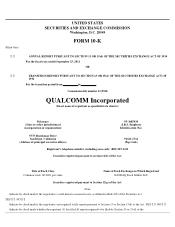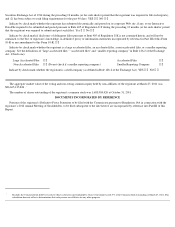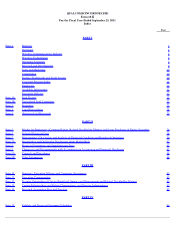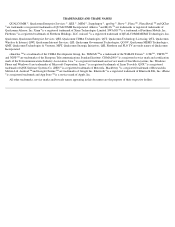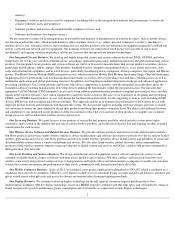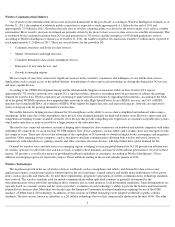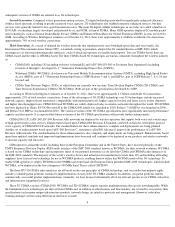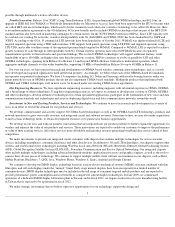Qualcomm 2011 Annual Report Download - page 12
Download and view the complete annual report
Please find page 12 of the 2011 Qualcomm annual report below. You can navigate through the pages in the report by either clicking on the pages listed below, or by using the keyword search tool below to find specific information within the annual report.
with all major air interfaces, our gpsOne technology was the industry’s first fully-integrated wireless baseband and assisted global positioning
system product and has enabled network operators to meet the Federal Communications Commission’s (FCC) E-911 requirements as well as
offer a wide range of services leveraging location data.
The Snapdragon family of processors is a highly integrated, mobile optimized system on a chip incorporating our advanced technologies,
including high performance central processing units (CPU), graphics processing units and modems, multimedia subsystems, including audio,
video and camera capabilities, and highly accurate GPS engines. Our CPU cores are custom designed to deliver high levels of compute
performance at ultra-low power, allowing manufacturers to design slim and powerful devices that last longer between charges. The Snapdragon
family also incorporates our modem technology for advanced mobile broadband and a feature-
rich multimedia subsystem that delivers audio and
high-definition video capabilities.
Our modems are built to work with increasingly complex networks. They support the latest communication technologies and adapt to
network conditions and user needs in real time to enable delivery of faster, smoother data and voice connections. Our 3G/4G modem roadmap
delivers the latest network technologies across multiple product tiers and devices. This roadmap is the result of our years of research into
emerging network standards and the development of chipsets that take advantage of these new standards, while maintaining backward
compatibility with existing standards.
Through our acquisition in May 2011 of Atheros Communications, Inc., which has been renamed Qualcomm Atheros, Inc. (Atheros), QCT
also offers an expanded portfolio of connectivity technologies, which complements its mobile business and extends QCT’s capability into
networking products. Atheros is a leading provider of wireless and wired connectivity products, including networking products for consumers,
carriers and enterprises, and mobile and fixed computing and consumer electronics products. Atheros’ wireless products consist of integrated
circuits and system software for WLAN, Bluetooth and frequency modulation as well as technologies that enable location data and services,
including GPS and GLONASS. Atheros’ wireless technologies are provided in the form of WLAN, Bluetooth and frequency modulation
integrated products, WLAN and Bluetooth combination products and standalone products. Atheros’ wired connectivity products consist of
integrated circuits and software for Ethernet, powerline and passive optical networks. Atheros’ wired portfolio enables delivery of richer, more
comprehensive multi-connectivity product platforms to its networking, computing and consumer electronics customer base. Atheros has
employed its WLAN, powerline and Ethernet technologies in combination to deliver hybrid platforms known as Hy-Fi products.
The market in which our QCT segment operates is intensely competitive. QCT competes worldwide with a number of United States and
international designers and manufacturers of semiconductors. As a result of global expansion by foreign and domestic competitors, technological
changes and the potential for further industry consolidation, we anticipate the market to remain very competitive. We believe that the principal
competitive factors for our products may include performance, level of integration, quality, compliance with industry standards, price, time-to-
market, system cost, design and engineering capabilities, new product innovation and customer support. We also compete in both single- and
dual-mode environments against alternative communications technologies including but not limited to, GSM/GPRS/EDGE, TDMA, TD-
SCDMA and WiMAX.
QCT’s current competitors include, but are not limited to, major companies such as Broadcom, CSR, Freescale, Fujitsu, Intel, Lantiq,
Marvell Technology, Mediatek, nVidia, Renesas Electronics, Spreadtrum Communications, ST-Ericsson (a joint venture between Ericsson
Mobile Platforms and ST-NXP Wireless), Texas Instruments and VIA Telecom, as well as major communications equipment companies such as
Ericsson, Matsushita, Motorola Mobility and Samsung, who design at least some of their own integrated circuits and software for certain
products. QCT also faces competition from some early-stage companies. Our competitors devote significant amounts of their financial, technical
and other resources to market competitive communications systems and to develop and adopt competitive digital cellular technologies, and those
efforts may materially and adversely affect QCT. Moreover, competitors may offer more attractive product pricing or financing terms than we do
as a means of gaining access to the market or customers.
Qualcomm Technology Licensing Segment (QTL). QTL grants licenses or otherwise provides rights to use portions of our intellectual
property portfolio, which includes certain patent rights essential to and/or useful in the manufacture and sale of certain wireless products,
including, without limitation, products implementing cdmaOne, CDMA2000, WCDMA, CDMA TDD (including TD-SCDMA),
GSM/GPRS/EDGE and/or OFDMA (e.g., LTE, WiMAX) standards and their derivatives. QTL licensing revenues are comprised of license fees
as well as royalties based on worldwide sales by licensees of products incorporating or using our intellectual property. License fees are fixed
amounts paid in one or more installments. Royalties are generally based upon a percentage of the wholesale (i.e., licensee’s) selling price of
licensed products, net of certain permissible deductions (e.g., certain shipping costs, packing costs, VAT, etc.). Revenues generated from
royalties are subject to quarterly and annual fluctuations. QTL revenues comprised 36%, 33% and 35% of total consolidated revenues in fiscal
2011 , 2010 and 2009 , respectively.
Separate and apart from licensing manufacturers of subscriber and network equipment, we have entered into certain patent arrangements with
competitors of our QCT segment, such as Broadcom, Fujitsu, Mediatek, NEC, Renesas Electronics, Texas Instruments and VIA Telecom. The
purpose of these arrangements is to provide our QCT segment and the counterparties
7


